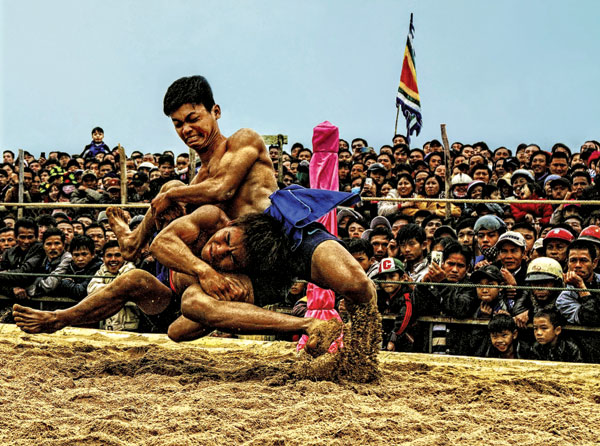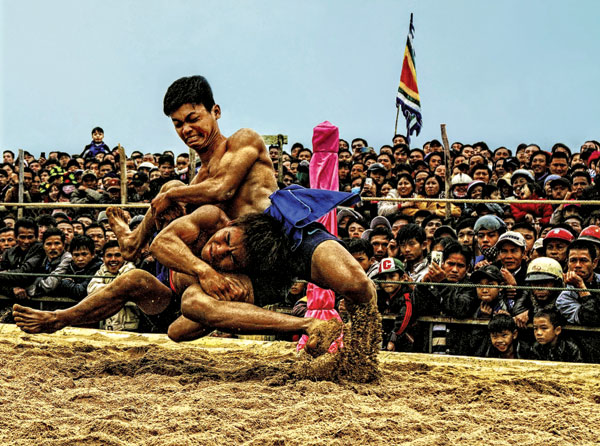(No.1, Vol.7,Feb-Mar 2017 Vietnam Heritage Magazine)
At the wrestling festival in Thu Le Village.
Photo: Nguyen Duc Tri

At the wrestling festival in Sinh Village.
Photo: Nguyen Huu Dinh
Creativity, not trickery,
is the key to winning at this sport
The sixth day of a new lunar new year might be the only day that all villagers of Thu Le in Thua Thien Hue Province wake up early all at the same time in a year. As the sound of drum beats and the smell of incense fills the village’s communal house for the traditional wrestling competition, the villagers gather.
In the middle of the communal house’s yard, a sandy bout is set in a round shape, ready for the wrestlers, who come from villages in the province’s Quang Dien District, Hue, to start their competition.
Throughout history, the first month in the lunar calendar was the time for recreation, as farmers were finally free from their farming work; the wrestling bout offered the villagers a great chance for entertainment.
An elderly man, Ngo Tuan, said that today the bout is held every year to maintain the village traditions and offers a sport to residents of villages around the district, which includes Thu Le Village. ‘The bout is to encourage young men in the district regular training for good health and teach them about playing fair,’ he said.
Rules of this traditional game require a competitor not to kick, punch or choke his rival during a fight. A referee will watch closely to stop harmful attacks and the rule violators will be sent away.
The wrestlers are allowed to use their hands to produce gestures that could fell their rivals. A winner of a session is determined when he makes his rival ‘dirty back and white belly’ (or l?m l?ng, tr?ng b?ng in Vietnamese), which means when he makes the rival fall on his back.
The game is very exciting and much applause will be produced for those wrestlers who use showy gestures to beat their rivals. A muscular or heavy man will not necessarily have the advantage in the game, as winners are usually a man with clever attacks, the knowledge of which are said to be transferred in families from generation to generation.
Certainly, competitors playing the game in tricky manner will receive boos from audiences. During a fight, an elderly man will beat a drum to inspire the wrestlers.
In Thu Le Village, the game starts first with performances among elderly men, then female wrestlers, and later, male competitors. A list of male villagers is made for the main game, which allows competition for teenagers and adults. Only residents of villages in Quang Dien District are allowed to play the game. Each competitor has to beat two rivals to enter the semi-final round, where he must defeat another for the final game. During the time competing tables for semi-final rounds are made, free players among audiences are welcome to enter a fight.
Four days later in Sinh Village in Phu Vang District, another wresting bout is held. Experts explained that there was more than one village in Thua Thien Hue that embraced the tradition, as some 200 years ago, wresting bouts were held to select healthy men as soldiers for the Nguyen Dynasty (1802-1945) in Hue.
Unlike in Thu Le, where the game is held similar to the traditional format, games in Sinh take place first in the village’s communal house with a bout performed for ritual procedure and later, the fights are brought out for the public to enjoy.
Competitors fight on a square sandy bout surrounded by temporary stages for audiences to stand on. There is no registration for fighters in advance, like in Thu Le’s rules. A competitor comes out from the audience stage, enters the bout and tries his best to win three fights for the semi-final game.
Of course, the competitors still abide by traditional rules, which state that a winner of a fight is one who can get his rival to fall on his back on the sandpit.
This game format allows more audience members to try the fight once, but it creates chance for illegal betting at the site.
Nostalgic audiences prefer the original format held in Thu Le, which they believe could help preserve the authenticity of traditional wrestling.

